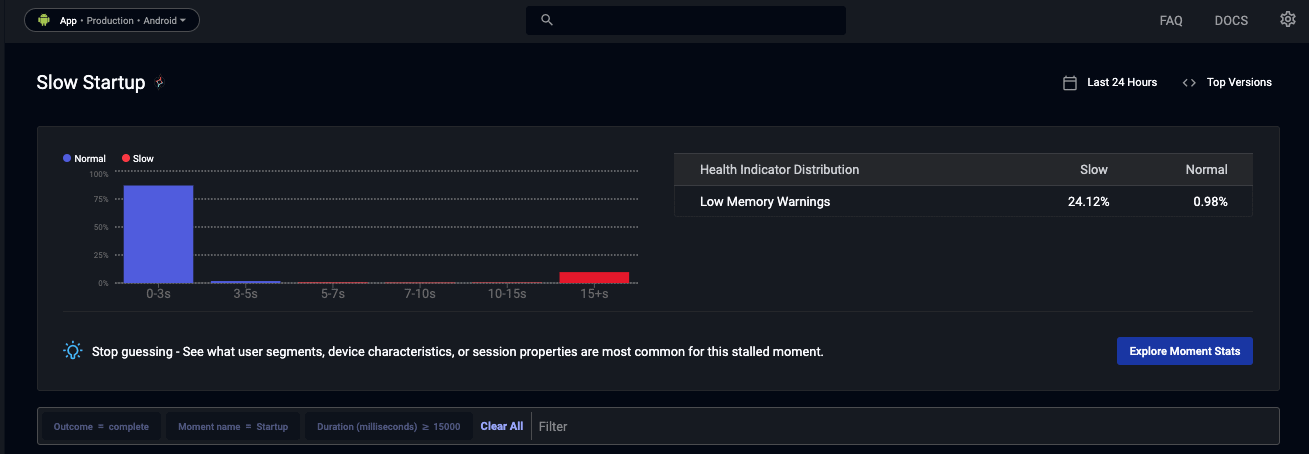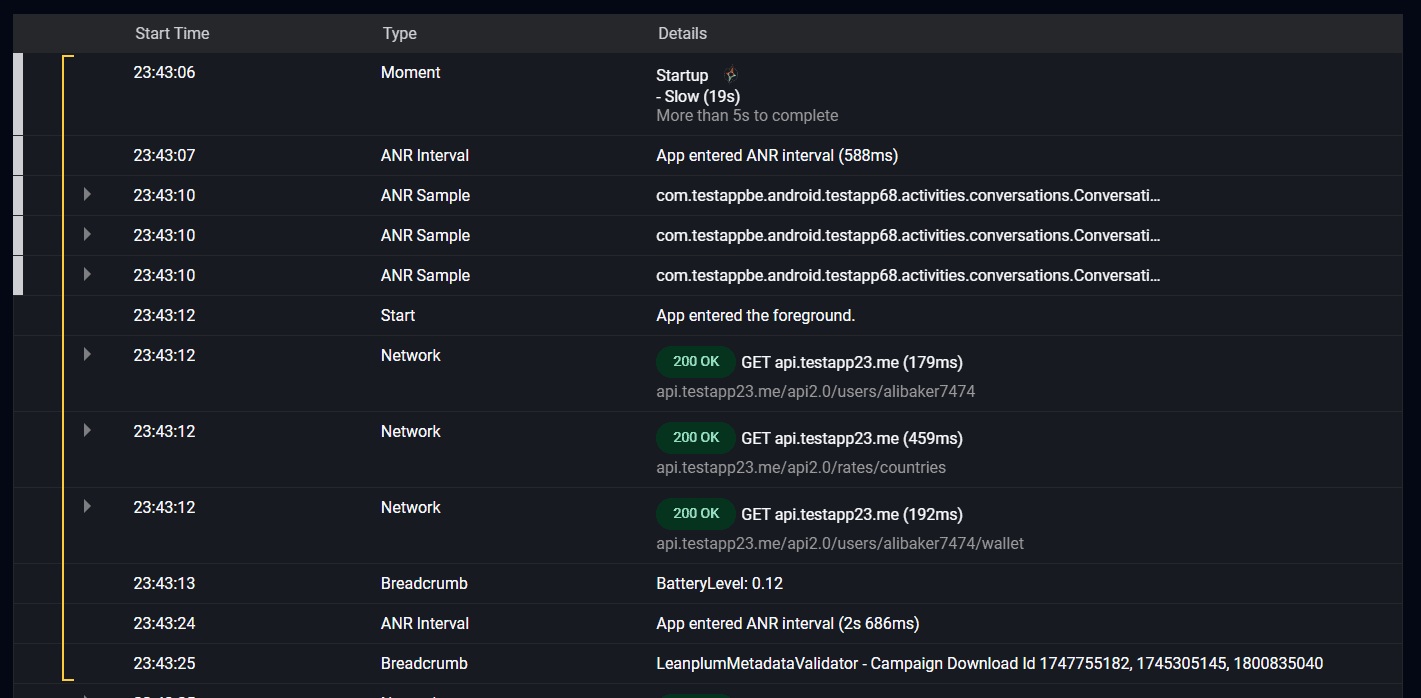Editor’s Note: This post was originally published on Apr. 16, 2021 and was republished on Mar. 1, 2023 to ensure that all content and links included are up to date.
Every time someone uses your mobile app, they must first launch it and … wait. Your startup time is like the waiting line for users to get into a restaurant. If you make them wait too long, they’ll simply decide to go elsewhere.
While there are many metrics to measure when evaluating a mobile app’s performance, startup time is one of the most important because it actively asks your users to be patient with your app. It is an obstacle preventing your users from experiencing that which your app has to offer. The moment they decide the wait isn’t worth it, you’ve lost them for good.
In this blog post we’ll cover:
- What is mobile app startup time?
- Why is it important to track and improve startup time?
- What is an ideal startup time?
- How can mobile teams improve their app’s startup time?
What is mobile app startup time?
For our purposes here, we’ll take a user-centric approach to defining startup time. It’s the length of time between when a user launches your app and when they can actually interact with it. It’s the price of admission before a user can experience your application. For a more technical deep dive, you can check out these posts by Apple and Google.
Why is it important to track and improve startup time?
A good first impression is key for retention. While churn can happen at any point during your user’s journey with your app, you do not want them to abandon it before they’re even past the starting line!
Keep in mind that 25% of mobile apps are only used once after installation. This is a significant percentage of potential users that you have convinced to install the app and your app has exactly one chance to convince these users to continue using it.
So how successful are apps when it comes to retaining users? Well, 60% of consumers abandon a mobile app after 1 usage if they face any performance-related problems. That’s quite the loss considering Cost Per Install (CPI) is hardly cheap. If 60% of your users abandon your app immediately after facing a slow startup, your team has failed to bring those users into the conversion funnel, and you’ve wasted 60% of your user acquisition costs.
And that’s not factoring in the negative impact on your brand equity. Over 52% of consumers agree that they are less likely to interact with a brand after a poor experience with their mobile app. So even if your other touchpoints have no issues, only one app needs to make a poor impression on consumers for your entire brand to suffer.
Even worse, your loss will become another’s gain.
Slow startups drive business to your competitors
Even if your users love your mobile app, you still must deliver a quick startup every time or risk them switching to a competitor. Though they might not uninstall your app outright, you are losing out on revenue. Disappoint them enough times and they will leave for good.
Chances are, your app has competitors and those competitors exist on your app’s store page in the “Related” or “Similar” section. This means that once your users have a bad experience they can check out your competitors after they’re done writing a 1-star review on your app store page!
Most users already have competing apps on their phone. For example, think about the food delivery space right now. There’s DoorDash, Postmates, Grubhub, ChowNow, and UberEats, just to name a few. If Food Delivery App A doesn’t load quickly enough, they will switch over to Food Delivery App B immediately. Not only will Food Delivery App A lose a user, Food Delivery App B will gain one. Your loss is your competitor’s gain.
Is your mobile app truly so unique that it can forego optimizing for performance? The competition is only intensifying with 100,000 and 30,000 new apps being released every month on Android and iOS respectively.
It is not enough to simply deliver an app that doesn’t crash. Yes, stability is important, but your app must delight users with seamless performance. Stability is now table stakes, and you must differentiate on performance.
What is an ideal startup time?
Let’s start with what most users consider to be excessive startup times:
- A cold startup that takes longer than 5 seconds.
- A warm startup that takes longer than 2 seconds.
- A hot startup that takes longer than 1.5 seconds.
In a cold startup, the system has not created the app’s process yet, so the system must launch and create a new process and bring all the app’s dependencies into memory.
In a warm startup, there is a process, but it is in a suspended state. In order to resume the app, we must reload all its pages into memory, but we can skip dependency resolution.
In a hot startup, there is a process, and it is in a background running state. Resuming the app requires no system actions other than presenting the buffer again.
If your app is exceeding the above benchmarks, you need to improve upon them. Warm launches should aim for under 1 second, and cold launches should aim for less than 2 seconds.
That means, no matter how a user is launching your app, your startup time should be less than 2 seconds.
Are you close to that ideal number, or are you drastically overshooting it? Your competitors are all targeting this benchmark, and your users can tell the difference. Don’t make the mistake of waiting to improve your startup time until users are leaving in droves.
The only way to be proactive instead of reactive is for your mobile team to make a habit of tracking your app’s startup time. And it must be an ongoing practice. This is because startup times tend to increase over time as new features and SDKs are added. When teams and apps grow, incremental changes add up over time. You must actively monitor and address regressions in performance. It’s not easy to strike a balance between maintaining growth and performance, but it is crucial for your company’s long-term success.
How can mobile teams improve their app’s startup time?
You need tooling that not only tracks your app’s startup time, but also points out the source of regressions. Thus, you need to track overall metrics alongside comprehensive session-level technical data that’s designed to solve any user-impacting issue.

The image above shows Embrace’s App Performance page that tracks the performance of key user moments like startup. Here, you can review the percentage of complete and incomplete startups as well as see which ones stalled, crashed, or were abandoned by users.

It’s also important to understand how your startup time varies across your users. With Embrace, you can see the breakdown of every key moment by its duration, and even better, you can dive directly into the individual user sessions to understand what’s causing slowdowns.

The benefit of monitoring your mobile app this way is that it seamlessly takes you from deep user insights to actionable data needed to improve mobile experiences.
What we’ve illustrated above is a complete way to go from monitoring a performance metric like startup time to understanding the impact across users and then diving into the technical details of what caused it.
This workflow results in improved efficiency and risk mitigation. Instead of relying on outdated monitoring practices that require your mobile team to cobble together logs, analytics, and errors from several tools to get the proper visibility, your team can get the complete picture from one platform. The ability to identify, prioritize, and solve issues without having to manually reproduce them translates to significantly reduced resolution times. In turn, this frees up more time for innovation and mobile growth initiatives.
If you’d like to see how complete mobile visibility can revolutionize how you deliver incredible mobile experiences, get started with a free trial today.
Get started today with 1 million free user sessions.
Get started free
